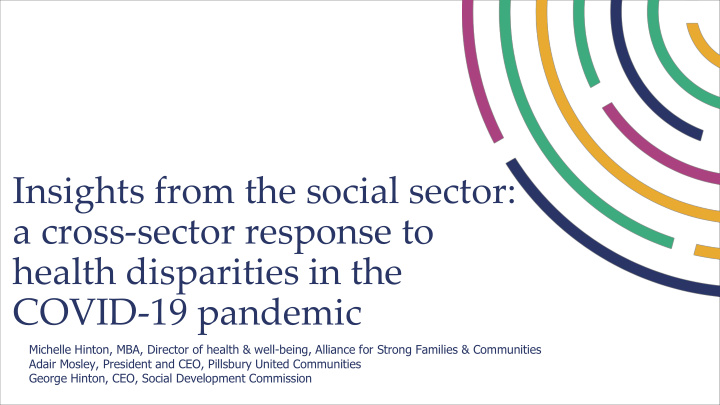



Insights from the social sector: a cross-sector response to health disparities in the COVID-19 pandemic Michelle Hinton, MBA, Director of health & well-being, Alliance for Strong Families & Communities Adair Mosley, President and CEO, Pillsbury United Communities George Hinton, CEO, Social Development Commission
Agenda - Introduction – Rebecca Sax, National Center for Complex Health and Social Needs - Housekeeping – Rebecca Sax - Presentation: -Michelle Hinton, MBA, Director of health & well-being, Alliance for Strong Families & Communities -Adair Mosley, President and CEO, Pillsbury United Communities -George Hinton, CEO, Social Development Commission - Q&A - Wrap-up & next steps – Rebecca Sax 2
Housekeeping - This event will be recorded - Please keep yourself on mute (by phone or Zoom platform) - All questions should be submitted through the Q&A feature 3
Insights from the social sector: a cross-sector response to health disparities in the COVID-19 pandemic Michelle Hinton Adair Mosley George Hinton Alliance for Strong Pillsbury United Social Development Families & Communities Communities Commission 4
Mic ichelle L. . Hinton Dir irector, , Health and Well-being
Social Determinants of Health (SDOH) • SDOH account for 60% of an individual’s overall health outcomes. • reduce health care costs and improve outcomes • Key Strategy -partnering with community-based organizations (CBOs) 6
COVID19, CBOs and Health Care Partnerships • COVID19 crisis has demonstrated to many health care partners the impact and efficacy of current community-based partnerships. CBOs are skilled in navigating the community environment, home stressors, and crisis states in which persons are now living, and adapt services quickly. Examples: food curbside delivery text supported home visits trauma-informed care. 7
Black Deaths by Location 90 80 70 60 50 40 30 20 10 0 District of Columbia Michigan Wisconsin Louisiana Illinois % of Deaths % of Population https://www.apmresearchlab.org/covid/deaths-by-race 8
MISSION WE ARE COMMUNITY BUILDERS CO-CREATING ENDURING CHANGE TOWARD A JUST SOCIETY. VISION WE IMAGINE THRIVING COMMUNITIES WHERE EVERY PERSON HAS PERSONAL, SOCIAL AND ECONOMIC POWER.
Form cross-sector partnerships focused on social determinants of health to improve community outcomes
$850,000 Community Pathways Hub Food as Medicine Building Capacity of Community Health Workers
Social Development Commission George Hinton, CEO
About Me: : Executive Children’s Health System of Wisconsin President Aurora Sinai Medical Center Milwaukee, Wisconsin CEO The Social Development Commission
What is the Social Development Commission? History: CAP Agency and Commission on Poverty Governance: Board of Commissioners, Appointed and Elected Funding: Majority Government
Local and National Trends Milwaukee is the 5th poorest city in the United States Source: Sanburn, Josh. "This is the Poorest Big City in the U.S." TIME Magazine 17 Sept. 2015; based on US Census Bureau, American Community Survey 2014 data Data shows that people in poor neighborhoods are less healthy than their more affluent neighbors but more likely to live in areas with physician shortages and closed hospitals. Source: A Pittsburgh Post-Gazette/Milwaukee Journal Nearly two-thirds of the roughly 230 hospitals opened since 2000 are in wealthier, mostly suburban areas. Source: A Pittsburgh Post-Gazette/Milwaukee Journal As health systems open those facilities, they have been closing their urban counterparts. The number of hospitals in 52 major cities in the United States has fallen from its peak of 781 in 1970 to 426 in 2010, a drop of 46 percent. Source: A Pittsburgh Post-Gazette/Milwaukee Journal
Health Care Crisis in an Urban Setting Proposed reduction in service Created a health care desert No community input
Summit on Poverty Highlights Marquette Univ iversity - Dr. Michael Lovell, President Asce cension Wis isconsin in - Bernie Sherry, Senior Vice President, WI Ministry Market Executive Soc ocia ial De Devel elopment Co Commission – George Hinton, CEO
A Health Care Collaborative Case Study: Milwaukee’s North Division High School
Case Study: North Division High School Collaboration Benefits: • Develop Wisconsin’s premiere high school with focus on health care • Provide local community with quality health care • Includes social services and wrap around programs • Partners: North Division students, teachers, administrators and alumni • Milwaukee Public School Central Office • Ascension Wisconsin • Universities including Marquette, MATC and others
Questions? Submit your questions through the chat feature 26
For more information National Center for Complex Health and Social Needs: • nationalcenter@camdenhealth.org Michelle Hinton: mhinton@alliance1.org • Adair Mosley: adairM@pillsburyunited.org • George Hinton: ghinton@cr-sdc.org • 27
Complex Care Resource Exchange LinkedIn group Share resources, opportunities, and questions among peers Join today! http://bit.ly/complexcareresourceexchange 28
We want your feedback! An evaluation survey will be sent out after this webinar 29
Camden Coalition of Healthcare Providers Thank you! National Center for Complex Health and Social Needs An initiative of the Camden Coalition of Healthcare Providers www.nationalcomplex.care @natlcomplexcare 800 Cooper St., 7 th Floor Camden, NJ 08102
Recommend
More recommend